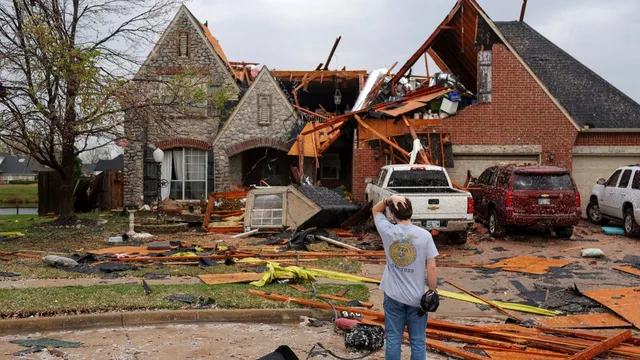
Severe storms threaten millions with tornadoes and flooding in the Midwest
2025-04-03 11:10- Severe thunderstorms, large hail, and tornado warnings have threatened millions across the Midwest and South.
- At least seven fatalities have been reported due to the impacts of the severe weather as storms continue.
- The storm system is expected to persist, leading to ongoing severe weather risks and potential flash flooding.
Express your sentiment!
Insights
In the United States, severe weather events unfolded on March 31, 2025, severely impacting the Midwest and Southern regions. A strong storm system brought thunderstorms, large hail, and destructive winds across Ohio, Mississippi, and the Tennessee Valleys, endangering up to 73 million people. Cities such as Detroit, Indianapolis, Memphis, Nashville, Chicago, Dallas, and Cleveland were particularly at risk as tornado warnings were issued. Reports of hail reaching three inches in diameter were confirmed in Oklahoma, alongside numerous damaging wind incidents reported over the weekend. The National Weather Service warned that very large hail, significant damaging winds reaching speeds of 60 to 70 mph, and strong tornadoes could be expected, especially during evening hours on Sunday. As storms moved eastward into Monday morning, an additional 68 million people faced risks in the Southeast and mid-Atlantic, with Alabama, Georgia, the Carolinas, and Virginia in the storm's crosshairs. Commuters woke up to severe thunderstorms, with damaging winds and the possibility of tornadoes spreading across these eastern regions. Following the extreme weather, at least seven fatalities were reported across several states due to the impacts of heavy rainfall, strong winds, and tornadoes. The storm system resulted in life-threatening flash flooding, especially in central U.S. regions previously hit hard by severe weather. Current forecasts indicated that over the ensuing days, additional severe weather would pose serious risks of flash flooding, extreme wind events, and further tornado activity through at least the beginning of the following week. Forecasters anticipated a sustained multiday severe weather threat, reminding residents to remain cautious as conditions could lead to widespread damage and hazardous travel scenarios. The threat not only involved severe thunderstorms but also wintry precipitation in northern regions, where winter advisories remained in effect. The total rainfall expected through the week raised alarms about possible flooding, particularly in areas where residents might face urban and river flooding, with flash flood watches already underway in various states. As the severe weather front continues, officials urged preparedness and vigilance in light of continuing risks.
Contexts
Severe storms have become an increasingly frequent phenomenon across the United States, leading to significant impacts on communities, infrastructure, and the environment. These storms typically encompass a range of weather events, including hurricanes, tornadoes, thunderstorms, and blizzards. The National Oceanic and Atmospheric Administration (NOAA) has noted trends in the intensity and frequency of severe storms, which correlate with changing climate patterns. Higher sea surface temperatures, increased atmospheric moisture, and more unpredictable weather systems have contributed to the worsening conditions observed in recent years. The consequences of these storms can be devastating, causing extensive property damage, loss of life, and displacement of residents, particularly in vulnerable regions along the coast and in tornado-prone areas of the Midwest and South. The economic ramifications of severe storms in the U.S. are profound. According to NOAA, the average annual economic cost of severe weather events has risen significantly, with losses amounting to billions of dollars annually. Industries such as agriculture, tourism, and construction often suffer as businesses and supply chains face interruptions. The recovery process can be lengthy and costly, placing additional strain on local and state governments tasked with rebuilding efforts. Furthermore, insurance claims following severe storms can lead to increased premiums, affecting both individual homeowners and commercial entities. As storms become more intense, the long-term financial implications are likely to persist, necessitating updates to building codes, infrastructure planning, and emergency preparedness strategies. Environmental impacts are another crucial aspect of severe storms. Flooding and storm surges can lead to the degradation of ecosystems and waterways, while intense winds from storms can cause significant damage to forests and wildlife habitats. Additionally, the aftermath of severe storms often includes contamination of water supplies and erosion of soil, which can have long-lasting effects on agriculture and biodiversity. In some cases, wildlife is forced to relocate due to habitat destruction, potentially leading to decreased populations and disruption of local ecosystems. Efforts to mitigate these impacts increasingly incorporate strategies to enhance resilience and adaptability across natural environments and urban landscapes alike. To address the challenges posed by severe storms, a multifaceted approach involving public policy, community engagement, and scientific research is essential. This includes investing in early warning systems to better predict and communicate storm threats, fostering a culture of preparedness within communities, and promoting sustainable practices that can decrease the vulnerability of both people and the environment. Collaboration among governmental agencies, non-profits, and the private sector is vital to creating comprehensive strategies that enhance resilience against severe storms. As climate change continues to influence weather patterns, understanding and addressing the full scope of severe storms' impacts will be increasingly important for safeguarding the health and well-being of the U.S. population.